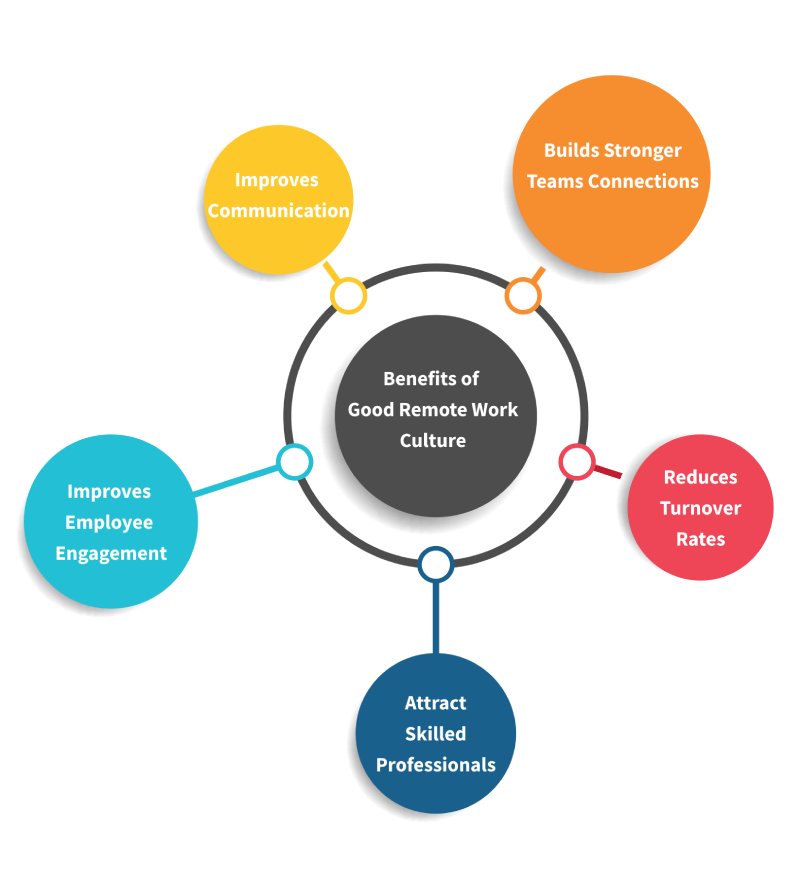Are you facing challenges maintaining your company culture in a remote work environment? Unsure how to build a strong remote work culture that keeps your team engaged and productive? Don’t worry! In this guide, you will learn about remote work culture, its benefits, challenges, and the best strategies to build a strong remote work culture with your remote team. Let’s dive in!
What is a Remote Work Culture?
Remote work culture defines the norms, values, and behaviors that connect employees who work from different locations, not physically at the same place. This culture relies on effective communication, collaboration tools, and a focus on trust and flexibility.
Remote culture ensures that every employee is supported and included in the workplace, even remotely. A good remote work culture ensures that the employees feel like they are part of the company and hence work better and are more engaged.
Benefits of Good Remote Work Culture
A good remote work culture helps to improve your organization’s performance and employee happiness. Here are some key benefits:

Improves Employee Engagement
A good remote work culture improves your employee engagement. when you give your team the freedom to work from anywhere makes them feel more in control, boosting motivation and productivity. Frequent check-ins, clear communication, and timely feedback keep your team connected to the company’s goals, maintaining high engagement.
Improves Communication
A positive remote culture improves communication in your company. With a clear and structured approach to communication, your team can communicate effectively. Tools like Slack, and Zoom keep your employees well-informed and connected as they work from different locations. These ensure smooth communication and fewer misunderstandings boosting productivity and collaboration.
Builds Stronger Team Connections
You can connect with your team members even if they are in different locations. Virtual team-building activities, regular online check-ins, or virtual coffee breaks will make your employees feel connected and supported which will boost collaboration and team vibe. By promoting virtual interactions you’ll have your employees work as one team even if they are not in the same place.
Reduces Turnover Rates
When employees have a good work-life balance, they are more likely to stay with your company long-term. By decreasing or preventing burnout and increasing job satisfaction, a strong remote work culture builds employee loyalty. This leads to lower turnover, saving you time and resources on hiring and training new staff.
Attracts Skilled Professionals
Skilled professionals look for flexibility in work and a healthy work-life balance. If you create a good remote work culture in your organization with the right tools, and clear communication, and offer flexible remote options make your company more attractive to top talent from anywhere in the world. When you value both productivity and employee well-being makes your company a top choice for professionals.
How to Build a Strong Remote Work Culture with Your Remote Team?
Creating a successful remote work culture is not an easy task and it takes time and effort. Here are some steps that help you create a successful environment for your remote team:

1. Prioritize Clear and Open Communication
Good communication is important for your remote teams to collaborate effectively. Make sure your employees can communicate with each other through clear, open lines of communication via tools like Slack, Zoom, or Microsoft Teams for live updates and quick meetings. Create a culture where open communication is encouraged, so that everyone feels valued and included. Through transparency and regular conversation, miscommunications can be avoided and the team can stay on track.
2. Set Goals and Expectations
Remote teams need to have clearly defined objectives and key results to ensure that they are focused. Identify goals for each employee and establish timelines for the work. This makes everyone responsible and on the same page with the objectives to be met regardless of the working environment.
3. Create a Structured Onboarding
When new employees join your team remotely, they need to feel welcome and supported from the start. A structured and good onboarding process that includes an introduction to the company culture, expectations, and tools can make a big difference. It helps employees understand how they fit into the organization, making them more confident and engaged.
4. Provide Right Tools
To create a successful remote work culture, you need to give the right tools to your teams to work together efficiently. Make your employees manage their projects, and see what tasks are assigned to them by providing project management software like Time Champ, Trello, or Asana.
Let your employees share and collaborate on documents using Google Drive and OneDrive. For quick updates, messaging, and video calls, offer communication tools like Slack or Microsoft Teams which helps to improve communication between your remote teams.
Additionally, use productivity tracking software like Time Champ to monitor work patterns, identify bottlenecks, and ensure employees stay on track without micromanaging. This boosts accountability, transparency, and helps in optimizing performance while promoting trust.
If you provide these tools to your remote teams, they can easily access information and track their progress easily without any confusion to meet deadlines which helps to increase your productivity and collaboration becomes smoother and more effective, making remote work easier for everyone, even when they are working from different locations.
5. Promote Team Building Activities
Promote virtual team-building activities such as games, quizzes, or virtual coffee meetings. These fun activities create a sense of connection, boost engagement, and help make your remote employees feel included as part of the team even if they are working remotely. Regular participation helps employees feel more connected and valued, boosting morale and reinforcing the sense that they are part of a cohesive team, even when working remotely. Such efforts can improve collaboration, motivation, and overall job satisfaction.
6. Establish a Clear Remote Work Policy
It is important to have a clear remote work policy in place so that employees know what is expected of them. It should include working hours, communication, performance, and policies on how to manage work and personal life. This policy helps avoid confusion on how the company handles remote workers, thus making it easier to manage your teams.
Case Studies: Companies with Strong Remote Work Culture
Some companies have set a great example of how to build and maintain a strong remote work culture. Here are three example companies:

GitLab
GitLab is one of the largest fully remote companies worldwide, with employees in over 65 countries. They excel in asynchronous communication, meaning that employees do not need to work at the same time. GitLab emphasizes transparency by documenting all company processes openly, ensuring that everyone stays informed.
Buffer
Buffer is one of the most famous companies that have a positive approach to remote work. The company has a flexible working schedule and allows employees to take breaks when they feel tired. Buffer also offers a home office allowance and a wellness fund, which proves that they care about their remote employees.
Zapier
Zapier is flexible and result-oriented in its operations. Their team works from different time zones and they use asynchronous communication to enhance their teamwork. Transparency is highly valued at Zapier, and the company makes sure that every employee has the necessary information to do their work effectively, regardless of where they are.
Challenges in Building a Remote Work Culture
Managing time zones in remote teams presents several challenges that can impact communication, collaboration, and overall productivity. Here are some key challenges organizations often face:
1. Lack of Face-to-Face Interaction & Communication Barriers
A common issue that arises with remote work is that employees do not get to interact with their colleagues physically. If people cannot talk to each other and read body language, there is a high chance of developing misunderstandings. This can result in loneliness and poor cooperation, which means that the employees cannot connect easily.
2. Maintaining Accountability and Productivity
Another major issue is to maintain accountability and productivity in work. One of the challenges that arise when employees are allowed to work from home is that it becomes difficult to monitor their performance and whether they are on track to meet certain deadlines. Lack of supervision can cause distractions and demotivation among the workers, which in turn affects the performance of the team.
3. Managing Time Zones and Work Schedules
If your team is working across multiple time zones, then managing the calendar and scheduling meetings is not an easy process. This can lead to problems in scheduling time for collaboration and can cause frustration among the team members who may feel that they are out of touch with their colleagues.
Best Practices to Overcome Remote Work Challenges
The following best practices can help address the common challenges of remote work:
Foster Team Connection with Virtual Meetups
Conduct virtual meetings at least once a week, whether it is a business meeting or just a cup of coffee. These meetups provide a platform for members of the team to interact outside the working environment, thus enhancing the feeling of togetherness in the team.
Provide Clear and Effective Communication Tools
Providing good communication tools helps your team stay connected easily. Apps like Slack or Zoom allow you to have quick chats or longer meetings, depending on what you need. This keeps everyone in touch, whether it’s for a quick update or a detailed discussion.
Track Progress with Project Management Software
To monitor your team’s progress, you can use project management software such as Time Champ, Trello, Asana. These tools help in assigning tasks, setting deadlines, and tracking the performance of the employees, thus making everyone responsible.
Promote Work-Life Balance with Flexible Hours
Flexible work schedules can be beneficial to employees in that they can be able to balance their working hours with their family and other responsibilities. Remind your team to set a schedule that they find comfortable and do not put pressure on them to work beyond their limit.
Use Scheduling Tools to Manage Time Zones
To address the issue of time zone differences, you should use scheduling tools to schedule meetings with your employees. This way, you will be able to guarantee that your team will be able to continue working efficiently even if they are in different time zones.
Conclusion
Establishing a strong remote work culture is essential to ensure your remote team’s effectiveness. If you pay attention to how you communicate, how flexible you are, and how you support your remote employees, you can create a positive remote work environment.
Even if you are facing some challenges such as communication problems, accountability issues, and time differences, it is possible to overcome these difficulties with the help of proper tools and approaches. In this way, you will ensure that your employees are motivated, engaged, and focused on achieving the objectives of your business while working remotely.
Frequently Asked Questions
In a positive remote work culture, remote employees are connected, supported, and appreciated even when they are not physically together. This results in increased efficiency and satisfaction among employees.
Companies can build a positive remote work culture by promoting clear communication, offering flexibility, and prioritizing employee well-being. Using the right tools and encouraging teamwork is key.
Some of the challenges include communication, how to ensure accountability, and working in different time zones. These can be overcome with the right tools and strong leadership.
Yes, a healthy remote work culture enhances concentration and work flexibility, which can result in increased productivity among remote workers.






